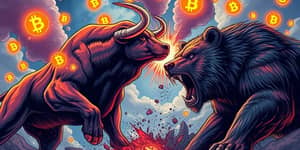As blockchain technology matures, the crypto landscape has segmented into three powerful pillars: NFTs, DeFi, and the metaverse. Each area exhibits unprecedented growth trajectories and innovation while converging to create a holistic decentralized ecosystem.
In this comprehensive analysis, we explore market dynamics, technological drivers, user adoption patterns, and practical steps to navigate these rapidly evolving sectors.
Understanding NFTs: Market Dynamics
Non-fungible tokens (NFTs) have redefined digital ownership by tokenizing art, collectibles, and virtual assets. The global NFT market is projected at $48.74 billion in 2025, with forecasts projecting growth to $703.47 billion by 2034 at a CAGR of 34.53%.
However, the space has seen revenue corrections, with estimates suggesting a drop from $683.9 million in 2024 to $608.6 million in 2025, highlighting a market recalibration after prior surges.
The user base is expanding steadily; 11.6 million global participants are expected by 2025, up from 11.58 million in 2024, though average revenue per user may decline from $162.10 to $59, indicating wider adoption with more moderate individual spend.
Key demographics include the 18–24 age group, which represents 14% of NFT interest, and 22% of U.S. millennials who actively collect NFTs. Platforms like OpenSea, with a trading volume of $14.68 billion, Rarible, Foundation, and SuperRare remain dominant marketplaces.
Decentralized Finance: Driving Innovation
Decentralized Finance (DeFi) leverages smart contracts to recreate financial services without intermediaries. This sector spans lending, borrowing, staking, and synthetic assets, all facilitated by programmable contracts.
Rapid protocol evolution has given rise to decentralized exchanges (DEXs), governance tokens, and interoperable solutions bridging layer-1 networks. Interconnected liquidity pools and automated market makers have fueled exponential growth in total value locked (TVL) across DeFi platforms.
Institutional interest is growing as compliance frameworks evolve, yet security vulnerabilities remain a critical challenge. Smart contract exploits and regulatory uncertainty pose risks, making rigorous audits and user education essential.
The Metaverse: The Next Frontier
The metaverse envisions immersive virtual environments where users socialize, work, and transact using blockchain-based assets. NFTs underpin digital property rights, while DeFi protocols power in-world economies.
Major platforms like Decentraland and The Sandbox allow users to purchase virtual land, build experiences, and monetize content. In-game economies are fueled by native tokens and NFT-based goods, creating vibrant digital marketplaces for creators.
As the metaverse evolves, real estate trading, virtual concerts, and on-chain payments are becoming commonplace. This convergence of social interaction and decentralized technology promises to reshape how communities connect online.
Integrating the Three Pillars
The true potential of blockchain emerges when NFTs, DeFi, and the metaverse interlace. NFTs serve as collateral in DeFi lending, while DeFi provides liquidity mechanisms for NFT trading. Both technologies underpin the economic infrastructure of virtual worlds.
For example, decentralized lending platforms accept NFT-backed loans, enabling collectors to leverage digital art as assets. Similarly, metaverse users stake tokens to earn rewards, further blurring lines between financial and virtual ecosystems.
Cross-sector synergy drives sustainable growth by offering new revenue streams and improving asset utility. This interconnectedness is the backbone of an emerging decentralized digital economy.
Sector Highlights and Use Cases
- Gaming: NFT-based in-game items and play-to-earn models project a $540 billion market by 2025.
- Music: Blockchain-powered rights management and exclusive drops forecast an $80 billion sector.
- Real-world asset tokenization: Fractionalized property, art, and memorabilia broaden investment access.
AI integration accelerates content creation and market analytics in the NFT space, while cross-chain protocols enhance DeFi interoperability. These technological drivers are shaping the next wave of innovation.
Practical Steps for Participants
Whether you are an investor, creator, or developer, navigating this landscape requires strategic planning and continuous learning. Consider these actionable recommendations:
- Conduct thorough due diligence on smart contract audits and platform reputations.
- Diversify across NFTs, DeFi protocols, and metaverse projects to balance risk and opportunity.
- Engage with communities on governance forums to stay informed about upgrades and proposals.
By adopting a measured approach, users can leverage early-mover advantages while mitigating volatility.
Market Projections and Comparative Table
Below is a snapshot of segment projections for 2025:
Challenges and Risk Management
Despite bullish projections, market corrections remain a reality. Weekly volume drops of over 20% have occurred, underscoring the importance of risk management. Regulatory ambiguity and security exploits necessitate constant vigilance.
To navigate these risks, users should prioritize platforms with robust security practices, maintain diversified portfolios, and stay abreast of regulatory developments in key jurisdictions.
Emerging Opportunities and the Road Ahead
Brands and creators can capitalize on NFT drops, virtual pop-up events, and co-branded experiences within metaverse platforms. Institutional adoption of DeFi products promises to unlock further capital, while AI-driven tools offer enhanced analytics and personalization.
Looking toward 2030 and beyond, the convergence of NFTs, DeFi, and the metaverse is poised to redefine digital economies, democratize access to assets, and enable immersive social interactions on a global scale.
By understanding the distinct dynamics of each pillar and their interdependencies, participants can position themselves for long-term success in this transformative era of decentralized innovation.
References
- https://www.statista.com/outlook/fmo/digital-assets/nft/worldwide
- https://www.prnewswire.com/news-releases/non-fungible-token-nft-market-to-grow-by-usd-84-13-billion-2025-2029-rising-demand-for-digital-art-boosts-the-market-report-on-ai-driving-market-transformation---technavio-302369528.html
- https://www.precedenceresearch.com/non-fungible-token-market
- https://fortunly.com/statistics/nft-statistics/
- https://www.coolest-gadgets.com/nft-statistics/
- https://economictimes.com/markets/cryptocurrency/metaverse-nfts-and-defi-three-crypto-use-cases-that-could-redefine-the-global-priorities-over-time/articleshow/88299711.cms
- https://coinbound.io/nft-stats/
- https://www.gemini.com/cryptopedia/defi-and-web3-explained-defi-crypto-options-web3-crypto










